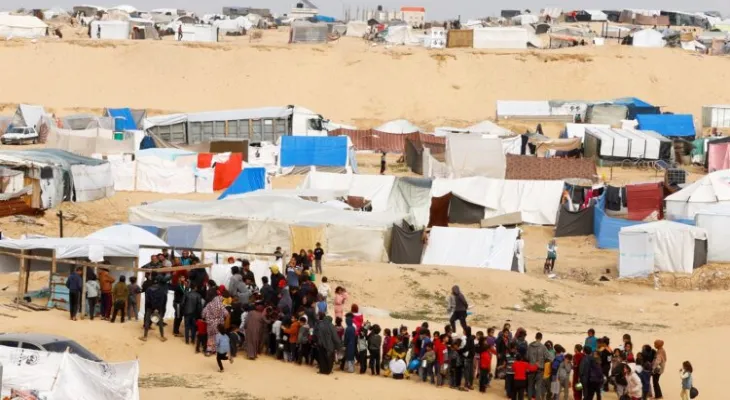Search here
Newspaper
Search here

Arab Canada News
News

Published: March 2, 2024
The chaos permeated by intense Israeli fire that led to the killing of 115 Palestinians while trying to get flour sacks from a aid convoy, highlights the desperation of hundreds of thousands struggling to survive amid the destruction that struck northern Gaza after nearly five months of fighting between Israel and Hamas.
Residents said they resorted to searching through piles of rubble and garbage for anything to feed their children, who barely eat one meal a day. Many families started mixing animal and bird food with grains to bake bread, while international relief officials say they faced catastrophic hunger.
Suad Abu Hussein, a widow and mother of five who took refuge in a school in Jabalia refugee camp, said on Saturday: "We are dying of hunger."
The Israeli air, sea, and ground attack has turned a large part of the densely populated area into rubble. The army asked Palestinians to move south, but it is believed that up to 300,000 people still remain in the area.
Karl Skau, Deputy Executive Director of the World Food Program, said this week that nearly one in six children under two in the north suffers from severe malnutrition and wasting, which is "the worst level of child malnutrition anywhere in the world." "If nothing changes, famine is imminent in northern Gaza."
Skau added that this has caused despair among the residents living there to the extent that they stormed trucks carrying food aid into the area and seized what they could, forcing the World Food Program to suspend aid deliveries to the north.
He said, "The collapse of civil order, caused by absolute despair, prevents the safe distribution of aid — and we have a duty to protect our staff."
In the violence that occurred on Thursday, hundreds rushed towards a group of about 30 trucks carrying aid before dawn to the north. Palestinians said Israeli forces nearby fired at the crowds. Israel said it fired warning shots at the crowd and insisted that many of the dead were trampled in the stampede. Doctors in Gaza hospitals and a UN team that visited a hospital there said large numbers of the wounded were shot.
Ahmed Abdul Karim, who was being treated at Kamal Adwan Hospital for gunshot wounds in his legs, said he spent two days waiting for aid trucks in the area before Thursday’s convoy arrived.
"Everyone attacked these trucks and advanced on them. Because of the large number, I couldn’t get flour.” He added that Israeli forces then shot at him."
Radwan Abdel Hay, a father of four, heard a rumor Wednesday evening about an aid convoy on its way. He and five others took a donkey-pulled cart to meet it and found "a sea of people" waiting for aid.
He added that when the convoy arrived, people spread out towards the trucks to get whatever food and water they could. He said that when they reached the trucks, "the tanks started shooting at us." "As I was returning, I heard tank shells and gunfire. I heard people screaming. I saw people falling on the ground, some motionless.”
Abdel Hay fled and took shelter in a nearby building with others. He said that when the shooting stopped, many dead were lying on the ground. "We rushed to help evacuate the wounded." He said, "Many of them were shot in their backs."
Widow Abu Hussein said that more than 5,000 people, mostly women and children, live with her in the Jabalia school and have not received any aid for more than four weeks. She said adults eat one meal or less to save food for the children.
She added that a group of people went to the beach to try fishing, but three were killed and two wounded by Israeli navy fire. "They just wanted to get something for their children."
The Israeli army did not immediately respond to a request for comment.
Mansour Hamed, a 32-year-old former relief worker living with more than 50 relatives in a house in Gaza City, said people resort to desperate measures to find something to eat. Some eat tree leaves and animal food. Some sift through rubble and abandoned homes looking for old food. He added that it has become normal to find a child coming out from under the rubble with a piece of moldy bread.
"They are desperate. They want anything to survive.
Recognizing the difficulty of delivering aid and the dire need for food, U.S. President Joe Biden said Friday that the United States will soon start air-dropping aid to Gaza and will look for other ways to bring in shipments, "including possibly a maritime corridor."
Relief workers hoped that a possible ceasefire would allow them to deliver food to the hungry across Gaza. A senior Egyptian official said ceasefire talks would resume Sunday in Cairo. The official spoke on condition of anonymity because they were not authorized to speak to the media.
International mediators hope to reach an agreement on a six-week cessation of hostilities and an exchange of some Israeli hostages with Palestinians held by Israel before the start of the holy month of Ramadan on March 10.
Meanwhile, the fighting continued. The Gaza Health Ministry said the number of Palestinians killed by the war rose to 30,320. The ministry does not distinguish between civilians and fighters in its figures, but says women and children make up about two-thirds of the dead.
Comments